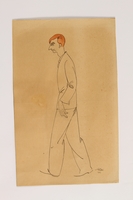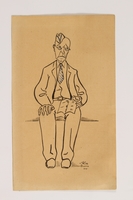Overview
- Description
- Copies of the Deggendorf "Center Revue" newspaper from the Deggendorf displaced persons camp; issues included are November 1945 (issues 1 and 2); January 12; January 26; February 15; February 28; March 15 (3 copies); March 30; April 15; May 18; and Jul. 8, 1946. The newspapers include caricatures and cartoons drawn by Annemarie Durra. Also includes one directory of inhabitants of the Deggendorf displaced persons camp as of January 1, 1946.
- Date
-
inclusive:
1945-1946
- Credit Line
- United States Holocaust Memorial Museum Collection, Gift of Kathryn Sucher
- Collection Creator
- Annemarie Durra
- Biography
-
Annemarie Loewe was born on June 23, 1909, in Breslau, Germany (Wroclaw, Poland), to Oskar and Margarete Kassel Loewe, and was Polish. Annemarie was a professional cartoonist. She sang in the choir at the Breslau Synagogue. She married the director of the choir, Wilhelm (Willi) Durra on January 7, 1941. Willi was born on December 7, 1882, in Brieg, Germany (Brzeg, Poland), to Benjamin and Minna Schlesinger Durra. This was his second marriage; he had three children with his first wife, who died in 1920 during the Spanish flu epidemic. Willi was an independent businessman.
Adolf Hitler was appointed Chancellor of Germany on January 30, 1933. Anti-Jewish decrees were enacted to severely restrict Jewish participation in German society. In 1933, Breslau had a Jewish community of about 20,000, one of the largest in Germany. The main synagogue was destroyed by fire during the Kristallnacht pogrom on November 9-10, 1938. The Jewish population now numbered only a little over 10,000. Those still in Breslau were in forced labor service. On April 2, 1943, Annemarie and Willi were deported on transport 57-IX/4 to Theresienstadt ghetto-labor camp in German occupied Czechoslovakia. The camp was primarily a collection center for deportations to ghettos and killings centers in the east, but Annemarie continued to draw and Willi directed a choir of inmates. On October 16, 1944, Willi was deported. Annemarie was liberated on May 9, 1945, when the Soviet Army entered the camp, two days after Germany’s surrender.
On July 16, Annemarie was transferred to Deggendorf displaced persons camp in the American zone in Germany, arriving there on August 9. Other survivors from Theresienstadt were at the camp, and there was an active cultural community. Annemarie sang in some of the theatrical performances. She contributed illustrations to the Deggendorf Center Review, a newspaper issued by the Department of Culture of the Jewish Committee in the camp.
Annemarie learned that Willi had been killed in fall 1944, not long after he arrived at Auschwitz-Birkenau. Late in 1946, she filled out a US Army questionnaire about her status as a displaced person and expressed interest in emigration. On February 10, 1950, she boarded the USAT General J H McRae in the port of Bremerhaven and arrived in America on February 21. She settled near extended family in California. Several of her drawings from Theresienstadt and Deggendorf were included in books about the Holocaust published in the early 2000's. Annemarie, age 93, died on April 25, 2003, in Oakland, California.
Physical Details
- Genre/Form
- Newspapers. Registers.
- Extent
-
1 folder
Rights & Restrictions
- Conditions on Access
- There are no known restrictions on access to this material.
- Conditions on Use
- The Museum is in the process of determining the possible use restrictions that may apply to material(s) in this collection.
Keywords & Subjects
- Geographic Name
- Deggendorf (Germany)
- Corporate Name
- Deggendorf (Displaced persons camp)
Administrative Notes
- Holder of Originals
-
United States Holocaust Memorial Museum
- Legal Status
- Permanent Collection
- Provenance
- Kathryn Sucher donated her family's collection to the United States Holocaust Memorial Museum on Jun. 7, 2004.
- Record last modified:
- 2023-02-24 13:43:39
- This page:
- https://collections.ushmm.org/search/catalog/irn86177
Download & Licensing
- Copyright Not Evaluated
- Terms of Use
- This record is not digitized and cannot be downloaded online.
In-Person Research
- Request 7 Days in Advance of Visit
- Plan a Research Visit
-
Request in Shapell Center Reading Room
Bowie, MD
Contact Us
Also in Annemarie Loewe Durra collection
The collection consists of two caricatures, thirteen newspapers, and a directory relating to the experiences of Annemarie Loewe Durra during the Holocaust when she was interned at Theresienstadt ghetto-labor camp in German occupied Czechoslovakia and after the war when she lived in Deggendorf displaced persons camp in Germany.
Date: 1944-1946

Caricature of a red haired man walking by an inmate of Theresienstadt
Object
Ink line drawing of a red haired man in a suit drawn by Annemarie Loewe Durra in 1944 when she and her husband Willi were interned at Theresienstadt ghetto-labor camp in German occupied Czechoslovakia. Annemarie and Willi were deported from Breslau, Germany on April 2, 1943. They were among the last remaining Jews in the city. Theresienstadt played a unique rule as a propaganda tool for the Germans. While by 1943, it was primarily a collection center for deportations to ghettos and killings centers in the east, the camp had an active cultural community. Annemarie, a professional illustrator, continued to draw and Willi, previously the choral director of the Breslau synagogue, directed a choir of inmates. On October 16, 1944, Willi was deported and murdered in Auschwitz-Birkenau killing center. Annemarie was liberated on May 9, 1945, when the Soviet Army entered the camp, two days after Germany’s surrender. On August 9, she was transferred to Deggendorf displaced persons camp in Germany. 2004.357.1 includes several newspapers published in Deggendorf with illustrations by Annemarie; 2007.162.9 is portrsit she drew in Deggendorf. In February 1950, she emigrated to the United States.

Caricature of a man seated with a paper by an inmate of Theresienstadt
Object
Ink line drawing of an apprehensive man sitting with a notice in his lap drawn by Annemarie Loewe Durra in 1944 when she and her husband Willi were interned at Theresienstadt ghetto-labor camp in German occupied Czechoslovakia. Annemarie and Willi were deported from Breslau, Germany, on April 2, 1943. They were among the last remaining Jews in the city. Theresienstadt played a unique rule as a propaganda tool for the Germans. While by 1943, it was primarily a collection center for deportations to ghettos and killings centers in the east, the camp had an active cultural community. Annemarie, a professional cartoonist, continued to draw and Willi, who had been the choral director of the Breslau synagogue, directed a choir of inmates. On October 16, 1944, Willi was deported and murdered in Auschwitz-Birkenau killing center. Annemarie was liberated on May 9, 1945, when the Soviet Army entered the camp, two days after Germany’s surrender. On August 9, she was transferred to Deggendorf displaced persons camp in Germany. 2004.357.1 has newspapers published in Deggendorf with illustrations by Annemarie; 2007.162.9 is a portrait she drew there. In February 1950, she emigrated to the United States.



